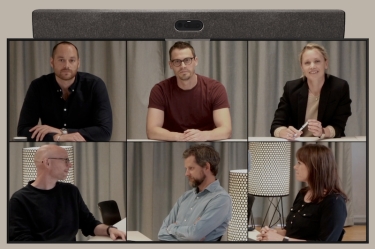iTWire previously demoed a Neat video bar and was majorly impressed. If you've had your fair share of Teams, Zoom, WebEx, Meet, Chime, BlueJeans, and other kinds of virtual meetings, you know how difficult engagement can be. This is especially the case when you're on the not-in-office side of the call. Imagine your typical conference room with a single camera focused on a meeting table that has people near and far, talking over themselves, talking to themselves, and you are trying to keep track of who's speaking.
Neat solves this with impressive software smarts. Its camera automatically picks up individual people and places them in their own focused split-screen, instead of simply displaying the entire room. It will focus on the active speaker or speakers. It will detect when people leave or enter the room and adjust its split screen to suit.
It really is very clever, and makes a huge difference in running meetings where people are engaged and conversing and collaborating, vs. a meeting where those in the room are leaving the remote viewers behind. Neat regional director ANZ Jason MacBride spoke to iTWire to explain what else Neat is doing to remove pain points for companies large and small, national and worldwide.
|
|
MacBride joined Neat at the end of 2023, but has been in unified communications for a decade, and in IT generally for twice that. He's worked with Poly, Nexon, Dell, and other big names. However, despite this extensive heritage and experience, he explains he was "hugely excited to join the Neat organisation."
"What I see Neat's products doing, and bringing to market, is fresh and new, and well overdue. What they've done over the last four years is absolutely incredible," he said.
As iTWire readers well know, many organisations are bringing people back to the office, including hybrid capacities. Some companies are more successful than others in this endeavour. "It's a real challenge for a lot of organisations right now," MacBride said. "After so much flexibility people realise they have a choice in how and where they work. Companies see they have to up their game and are challenged by how to provide a high-quality experience in the office space. It's no longer acceptable to think you can just throw a camera in a room, and say 'close enough is good enough'."
"The actual quality of the experience is important," he said. "Organisations must redesign and rethink their office footprint, and importantly, the spaces and what to do to give staff the right experience."
One of Neat's global customers is none other than Atlassian, themselves. "They use the whiteboarding facility heavily," MacBride said. "Atlassian see themselves as a collaborative company, and by leveraging Neat's all-in-one Neat Board they have the flexibility and freedom to whiteboard and have high-quality video conferencing in one device."
The issue of cramped meeting rooms with large tables is only one pain point; "the requirement for video conferencing is not bound by any specific sector or vertical. Almost all companies are using video nearly on a daily basis," he said. "On any given day, someone is joining remotely because they're sick, or working from home, they're travelling in a car ... using video is absolutely ingrained in us and is here to stay."
Additionally, "audio is the most common pain point," MacBride said. "Poor audio is a real killer. And poor video - where you can't see people, their facial expressions, and who's at the end of the table - is unengagning."
By contrast, "the Neat philosophy is all about keeping it simple. We want the out-of-box experience to be pleasant, and the in-room experience to be fantastic. And the device management needs to be fantastic too," he said.
This is where Neat excels; while it's possible to speak in terms of hardware specs (12 megapixels, 120-degree field of view, 4x-8x digital zoom, 5 microphone array, even air quality sensors) it would be a mistake to compare Neat's video bar and board against other hardware vendors, spec-by-spec. It can hold its own, of course, but the important thing to note is Neat is not simply hardware; it's also simple device management and smart built-in software that gets to the heart of why people video-conference to ensure communication, collaboration, and engagement all take place.
"Hutt City Council in New Zealand recently redesigned their offices with a full refit," MacBride said, "and they selected Neat, partly because of the simplicity of the solution."
Meanwhile, artificial intelligence is a hot topic everywhere, and Neat is no different. "A recent statistic I came across was companies using collaboration tools with AI are over 50% more productive," MacBride said. "Neat absolutely leverages AI hugely. Our symmetry software uses AI to help us frame participants. Whether you are at the front or back of the meeting room, our tech can frame you and represent you in your own tile. It makes for a more inclusive meeting, and everyone is able to communicate."
This is, of course, the split-screen smarts referred to earlier. However, Neat has continued to build on the smarts and the experience here. For one, the company has a Neat Centre which sits in the middle of the room with 360-degree cameras. When the conversation is among people around a table, the camera will frame them - giving people on the far side a front view of the speaker's faces. However, if everyone starts looking at the screen then the camera in the front of the room detects this, and frames from the front camera. This is a huge departure from the typical webcam-experience where remote participants only see the side of heads when the room is speaking amongst itself.
Additionally, the evolving Neat AI can leverage overlapping cameras to ensure nobody is ever out of focus or split in half. "The most powerful thing, I think," MacBride said, "is it knows the difference between a 2D and 3D person. The camera will not frame those people - it knows they not a human." - meaning, for instance, Neat won't devote a split screen or tile to photographs on the wall, even lifesize cutouts you might have for marketing or promotional purposes. "Neat is the first to market with this."
Further, when you're standing at the front of the room and are standing by the screen, or showing content next to the screen, the camera can frame you at the front. "The ability for people to see you is a real common challenge. People want to see the presenter at a Town Hall."
iTWire thinks Neat is neat, and if you use it yourself, you will also. If your business is focused on what it needs to do to bring people back into the office, you know the importance of having people together. As tremendous as remote working is, there's no substitute for in-person experiences. To this end, the biggest trend MacBride is seeing across Australian and New Zealand businesses is office redesign. "Companies are rethinking footprint in terms of how much square footage they have, and how to leverage space in a better way. We're seeing a huge explosion of focus rooms and one- to two-person quiet sanctuaries, along with increased four-to-six person meeting rooms."
"When you come to the office, if you can't get a room, if you can't use tech to remain productive, people just won't come back," MacBride said. "It needs to be all about making sure you have the right fit-for-purpose solution."
"There are a lot of competitors out there, but not all are created equally," he said.
In other news, MacBride says Neat has released a 50" version of its existing 65" Neat Board. "What's unique is the screen has an anti-weight mechanism due to its lighter nature. It can slide up and down on a wall or trolley. As it's lighter on the trolley, it's super easy to move on wheels too. The height-adjustable screen can go quite low if you're at a desk; it's great for education and whiteboarding. And it's made from 70% recyclable materials. It's great engineering and has been well received for its short time out on the market."
If you're keen to test Neat for yourself, MacBride says you can contact the company for a demo using a Neat Centre, or have an in-person demo. Alternatively, the company has a trial program so you can test the unit for 30 days in your own environment. At the end of the 30 days you can either purchase it, or box it all back up and let Neat collect it.
"We give customers a whole bunch of different options to see it, experience it, touch it, and to see the management platform," he said.











































